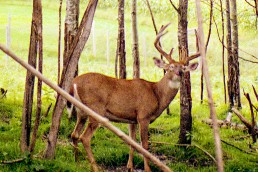Hunting Farm Country Bucks
SHARE THIS POST
Farm country deer are more familiar with human behavior, but Dr. Ken Nordberg provides insight to these animals that can reestablish the advantage to the hunter.
Though mature farm country bucks are generally seen more often than forest region bucks, they are nonetheless more difficult to hunt. They are far more familiar than forest deer are of differences in behavior between humans who are not hunting deer, and humans who are. For example, while a farmer is working in a field or relaxing around his yard, mature whitetails in the vicinity will typically act as if he is harmless. While the same farmer is afoot away from the house, still-hunting—sneaking, often halting and changing direction—or taking part in a drive, those same deer will act as if he is very dangerous.
Recognizing dangerous hunting behavior in humans enables experienced farm country whitetails to identify and quickly take advantage of areas in which humans do not hunt deer. The ability of trophy-class bucks, seen feeding close to farm homes all summer long, to disappear before deer hunting begins, reveals they even recognize changes that mysteriously warn them when it’s time to retire to a safe sanctuary.
Common among vast fields of soybeans, corn and other tall farm crops in farm areas are brushlands and wooded areas of various sizes, including forested watercourses, wetlands, pastures, woodlots and tree lines. In spring, such wooded areas are crowded with deer, until farm crops such as corn become tall enough to allow them to spread out into individual home ranges, similar in size of those of forest deer.
The largest of whitetail home ranges, which circumvent smaller home ranges of 15 to 30 other deer, are those of dominant breeding bucks. Though their home ranges may be 1 to 2 square miles in size, like those of forest bucks, their ranges tend to be unusually long (up to five miles), narrow and irregular, crossing portions or entire extents of many farmlands, some of which may be posted. This can make it very difficult, if not impossible, for one hunter to hunt close to one big buck day after day, if at all. In farm regions, most hunters end up hunting mere fractions of trophy buck home ranges, greatly reducing the odds of even seeing one.
Yet, even in farm country, there are reasons and seasons during which older bucks can be unusually vulnerable to skilled stand hunting. The word “skilled,” in this case, means something quite different from the way most stand hunters stand hunt these days—using one stand site and some kind of a lure throughout a hunting season. Bucks that survive three or more years of such hunting become very skilled at discovering, identifying and avoiding hunters who stand hunt this way, because they have excellent memories. In addition, overused buck lures inevitably lose their allure, and become added reasons such hunters are easily identified and avoided by such deer.
Are you enjoying this post?
You can be among the first to get the latest info on where to go, what to use and how to use it!
Often changing to never-used-before stand sites is one potent way to improve the odds of outsmarting such bucks. Selecting stand sites with enough natural cover (or terrain) to hide the hunter’s approach and silhouette while seated at a stand site is another. Selecting stand sites within easy shooting distance of very fresh, mature-buck-sized hoof prints of a walking deer, and/or droppings, is essential.
Minimizing trail scents while selecting and preparing stand sites has to be a top priority. Displaying no hunting behavior (instead, walking nonstop at a moderate pace with your head pointed straight ahead) while hiking to or from a stand must be another priority.
Approaching from downwind or crosswind, and sitting downwind or crosswind of trails or sites where you expect a big buck to be currently located, or likely soon will be—revealed by very fresh deer signs—is another priority. This means you need to know where the odds will be best for seeing a mature buck right now, later today or tomorrow morning—based on predictable habits and behavior of whitetails and freshly made deer signs. Never missing a minute of daylight hours when whitetails normally feed—hours mature bucks are most active, most predictable and most visible—should always be a top priority.
There’s more than one way to hunt whitetails. Learn some new methods in the fall issues of MidWest Outdoors, available the first full week of each month at the newsstand or by subscribing on our website.
MWO
SHARE THIS POST
You may also like...
Nothing found.
Did you enjoy this post?
You can be among the first to get the latest info on where to go, what to use and how to use it!
Dr. Ken Nordberg
Based on his 55 years of field research, Dr. Ken Nordberg has written more than 800 magazine articles, 12 books on whitetails—including the famous Whitetail Hunter’s Almanac series—five books on black bear hunting and produced Buck and Bear Hunting School videos. You may peruse his encyclopedic website with whitetail hunting tips: drnordbergondeerhunting.com, his blog: drnordbergondeerhunting.wordpress.com, or social media pages.
